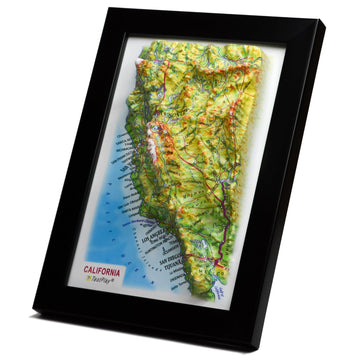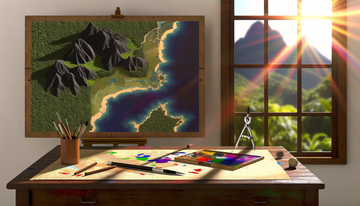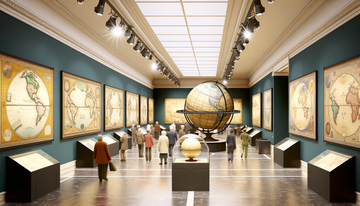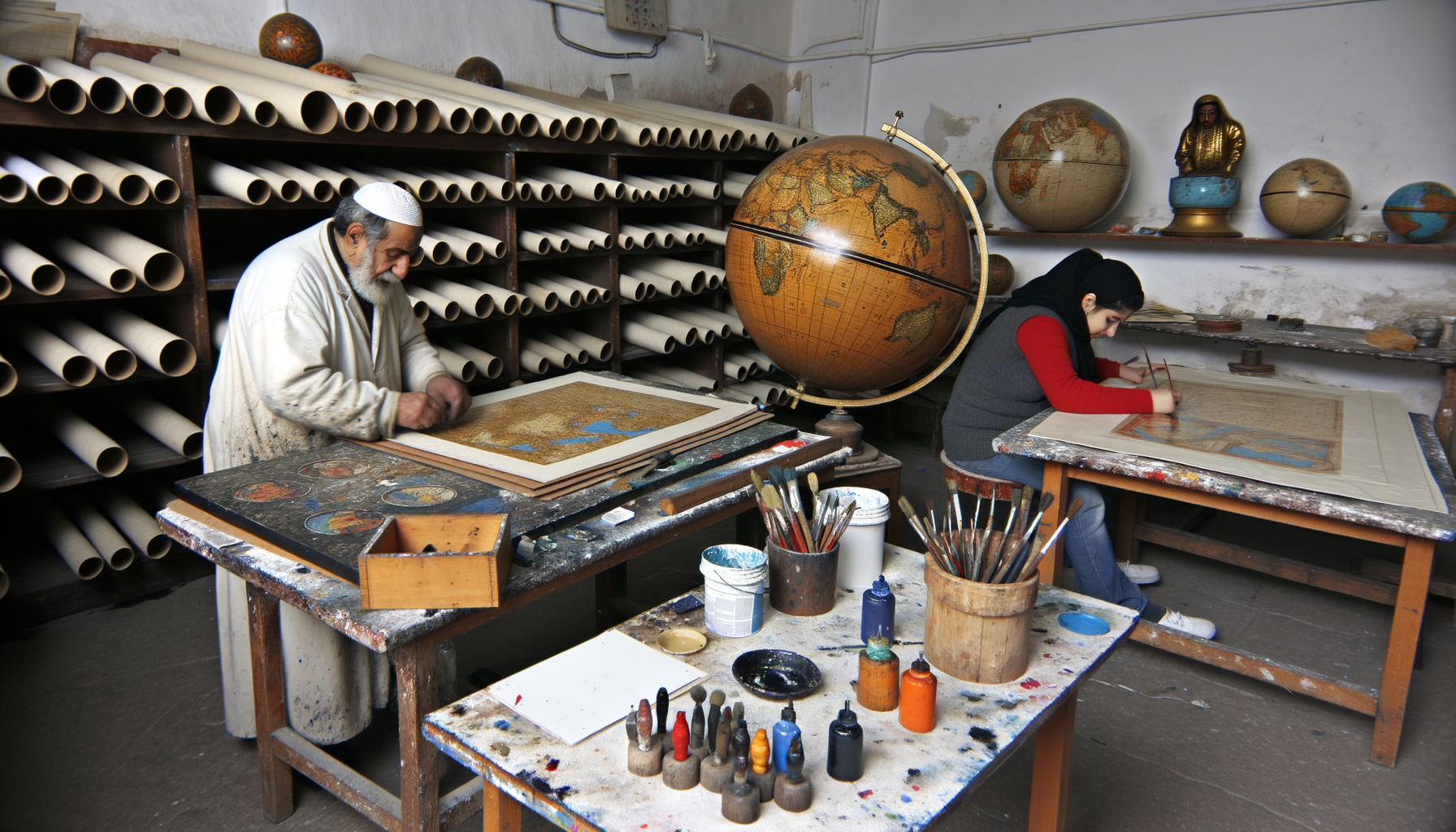The Craftsmanship of Globe Making: An Inside Look at Artisanal Globe Creation
Introduction: Unveiling the World in Your Hands
When you look at a globe, you see a miniature world, a perfect sphere capturing the vastness of our planet. While mass-produced globes are common, there exists a realm of exquisite artistry dedicated to creating these objects by hand, a tradition stretching back centuries.This blog post takes you behind the scenes of this fascinating craft, revealing the intricate processes, the dedication, and the immense skill required to transform raw materials into a spherical representation of Earth.
For those captivated by the blend of cartography, history, and tangible craftsmanship, understanding how these artisanal globes are made offers a profound appreciation for their beauty and value.
By exploring the journey from flat map to finished sphere, we illuminate the enduring appeal of handmade globes and provide insight into why they remain treasured objects in an increasingly digital age. This journey offers a solution to the common perception of globes as mere geographical tools, revealing them instead as complex, labor-intensive works of art.
A Rich History of Global Exploration
The story of globe making is inextricably linked to the history of exploration, cartography, and scientific discovery. Early globes were revolutionary tools, allowing scholars and navigators to visualise the world in a way that flat maps simply could not.From the rudimentary spheres of ancient Greece to the detailed, ornate globes crafted during the Age of Exploration, each era has left its mark on the evolution of this craft.
Master globe makers of the past, such as Mercator and Blaeu, were not only cartographers but also skilled artisans, constantly pushing the boundaries of accuracy and aesthetic appeal.
Their work laid the foundation for the techniques still employed by dedicated artisans today, proving that some crafts possess a timeless quality. Understanding this history provides a vital context for appreciating the lineage and dedication inherent in modern handmade globe production.
The Intricate Process: Bringing the World to Life
Creating a handcrafted globe is a meticulous multi-step process that requires immense patience, precision, and a diverse set of skills. It is a far cry from automated manufacturing, relying instead on the dexterity and judgment of experienced artisans.Each stage presents unique challenges, from ensuring the map is accurately rendered to achieving a perfectly smooth sphere and applying the paper without a single crease.
This detailed breakdown offers an inside look at the journey a globe takes from concept to completion, highlighting the dedication involved at every turn. It is in these steps that the true craftsmanship becomes evident.
Step 1: The Art of Cartography and Design
The foundation of any globe is its map, and for handcrafted globes, this involves a significant artistic and technical undertaking. While historical globes relied on hand-drawn and engraved maps, modern artisans often combine traditional cartographic principles with digital tools to create the base map data.This data must then be adapted specifically for a spherical surface, which involves complex projections to minimise distortion.
The map design itself considers not just geographical accuracy but also aesthetic qualities – the choice of colours, fonts, and graphical elements contribute significantly to the final look and feel of the globe.
This digital or hand-drawn map is then prepared for printing, typically on high-quality, durable paper.
Step 2: Forming the Perfect Sphere
The next critical step is creating the spherical core upon which the map will be applied. Historically, spheres were often made from materials like papier-mâché layered over a mould, or even from wood turned on a lathe.Contemporary artisans use various methods, including moulding spheres from plaster, resin, or a combination of materials, or starting with pre-formed, high-density foam or composite spheres that are then carefully prepared.
Regardless of the initial material, achieving a perfectly smooth, symmetrical, and durable sphere is paramount.
Any imperfection at this stage will be visible or cause issues when applying the map gores, necessitating careful sanding, filling, and finishing. This foundational step demands incredible precision and attention to detail.
Step 3: Printing and Applying the Map Gores
This stage is perhaps the most iconic and skill-intensive part of traditional globe making: printing the map onto tapered segments called "gores" and applying them to the sphere. The map is printed onto multiple identical gores, typically ranging from 12 to 24 depending on the size of the globe and the desired level of detail.Printing methods can range from traditional techniques like lithography or screen printing to modern, high-resolution digital printing, ensuring the colours are vibrant and the details are sharp.
The application of these gores is where the artisan's skill truly shines.
Each gore is carefully trimmed, often wetted to make the paper pliable, and then painstakingly pasted onto the sphere, starting from one pole and working towards the other.
The artisan must align each gore perfectly with its neighbours, smoothing out any wrinkles or air bubbles and ensuring the seams are virtually invisible.
This process requires immense patience, a steady hand, and a deep understanding of how the paper will behave as it dries and conforms to the spherical shape.
It is a slow and meditative task, with hours spent smoothing and aligning paper segments.
Step 4: Assembly and Adding the Details
Once the map gores are fully dried and bonded to the sphere, the globe begins to take its final functional form. This involves integrating the sphere with its mechanical components – the axis and the stand.A sturdy central rod or spindle is carefully inserted through the poles of the sphere, allowing it to rotate freely.
This axis is then mounted within a stand, which can range from simple wooden bases to complex brass or metal structures, often featuring a meridian ring.
The meridian ring is a calibrated circle, typically made of brass or other metal, that encircles the globe and allows for measurement of latitude.
Attaching the meridian ring accurately and securely is another step requiring careful alignment and precise metalwork or woodworking.
Many artisanal stands are works of art in themselves, crafted from fine woods, metals, or even incorporating intricate carvings or inlays.
Step 5: The Finishing Touches
The final stage involves adding protective layers and decorative elements that enhance both the durability and the aesthetic appeal of the globe. The map surface is typically coated with multiple layers of varnish or lacquer.This protects the paper and ink from environmental damage, dust, and fingerprints, while also giving the globe a pleasing sheen or matte finish.
Applying varnish requires careful technique to avoid brush strokes or uneven patches.
Additional details might include adding a compass inset into the base, an engraved plaque detailing the globe's specifications or edition number, or hand-painting specific features like ocean currents or ship routes.
For luxury globes, gemstones or precious metals might be incorporated into the stand or as markers on the globe itself.
Each finishing detail is executed with precision, elevating the globe from a geographical tool to a true heirloom-quality object.
The Materials That Build a World
The quality and longevity of a handcrafted globe are heavily dependent on the materials used throughout the process. Artisans carefully select materials not only for their functional properties but also for their aesthetic contribution.High-quality paper is essential for the map gores, chosen for its ability to absorb ink vibrantly, its durability, and its flexibility when wet for application to the sphere.
Pigments used in the inks are often lightfast and archival quality to ensure the colours remain true for generations.
For the sphere itself, stable and smooth materials like carefully prepared plaster or resin composites provide a solid and durable base.
The stands and mechanical components are frequently made from fine hardwoods such as walnut, cherry, or mahogany, and metals like solid brass or aluminium, chosen for their strength and beauty.
Inlays might use different woods, metals, or even mother-of-pearl.
The varnish or protective coating is selected for its clarity, durability, and finish – whether a traditional glossy look or a contemporary matte appearance is desired.
The deliberate choice of superior materials at every step underscores the commitment to creating a product built to last and be admired.
The Skills of a Master Glober
Creating a handmade globe is not a skill that can be learned overnight; it is the culmination of expertise drawn from various disciplines. At its heart lies cartography, requiring an understanding of projections, geography, and map design.However, this is just the beginning.
Paper handling skills are paramount, particularly in the delicate process of applying the wet gores to the sphere without creases or tears and achieving seamless joins.
An artisan must possess the precision of a sculptor or mould maker to create or refine the perfect sphere.
Printing knowledge, even if not performing the printing themselves, is necessary to understand how the map will appear on paper.
Furthermore, expertise in woodworking and metalworking is vital for crafting the intricate stands and sturdy mechanical components.
Finally, the finishing requires the steady hand and eye for detail of a painter or fine finisher, ensuring protective coatings are applied flawlessly and decorative elements are integrated harmoniously.
Patience, problem-solving ability, and an unwavering commitment to quality are intangible skills that define a master glober, making this a truly multi-faceted craft.
Tradition Meets Innovation: Modern Globe Making
While the core process of hand-applying gores remains largely unchanged for centuries, modern artisanal globe makers often blend traditional techniques with contemporary tools and knowledge. Digital cartography, for example, allows for unparalleled accuracy and the ability to create custom maps reflecting current geographical data or historical maps with precise detail.High-resolution digital printing enables reproduction of intricate designs and vibrant colours on the map gores.
Some materials used for the sphere or stand components might be modern composites offering enhanced durability and stability.
However, the defining characteristic of a handcrafted globe remains the significant amount of work done by hand – the formation of the sphere, the precise application of the gores, the hand-finishing, and the careful assembly.
This fusion of old and new respects the heritage of the craft while leveraging advancements to create globes that are both historically informed and technically superior.
It ensures that the craft evolves without losing the human touch that makes each globe unique.
The Enduring Appeal of a Handcrafted Globe
In an age where digital maps are instantly accessible on our phones, the appeal of a physical, handcrafted globe might seem surprising, yet it endures strongly. A globe offers a unique, intuitive understanding of spatial relationships that a flat map simply cannot replicate.You can spin it, trace routes across continents, and visualise the curvature of the Earth.
Beyond its educational value, a handcrafted globe is a magnificent object of art and design.
Its presence in a room speaks volumes about an appreciation for craftsmanship, history, and the world itself.
These globes are often seen as heirlooms, passed down through generations, carrying stories and adding character to a space.
They serve as a tangible connection to exploration, geography, and the meticulous work of dedicated artisans, offering a piece of the world that is both functional and profoundly beautiful. Owning one means possessing a unique work of art that represents countless hours of skilled labour and artistic vision.
Conclusion: A World of Craftsmanship
Exploring the world of handcrafted globe making reveals a process rich in history, demanding in skill, and beautiful in its outcome. From the initial cartographic design to the final layers of varnish, each step is a testament to the artisan's dedication and expertise.Understanding this journey allows us to see beyond the simple form of the sphere and appreciate the complex web of skills – from mapmaking and paper application to woodworking and metal crafting – that converge in its creation.
In a world often dominated by mass production, the handmade globe stands as a powerful symbol of enduring craftsmanship and the value of human touch.
Possessing such an object means holding a piece of art, history, and geographical knowledge, crafted with care to be admired for generations.
It is a reminder that the world, in its tangible form, can be a masterpiece.




